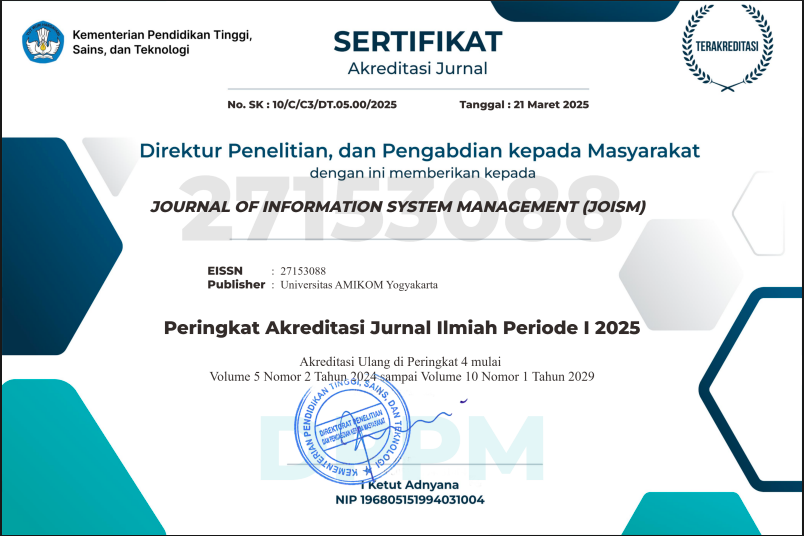WEBSITE PROMOSI WISATA BARU DI WILAYAH YOGYAKARTA DENGAN PENDEKATAN LEAN UX
DOI:
https://doi.org/10.24076/joism.2023v5i1.1000Keywords:
Destinasi wisata populer, Pengalaman Pengguna, Lean UXAbstract
Website resmi pariwisata Indonesia saat ini didesain untuk mampu menampilkan daftar tujuan daerah, dimana apabila salah satu daftar tersebut dipilih, informasi yang ditampilkan masih hanya berupa nama, deskripsi, jumlah yang disukai, jumlah yang dilihat dan penjelasan tentang daerah tersebut. Informasi tersebut belum lengkap untuk wisatawan yang ingin mencari atau menentukan tujuan wisata, terutama destinasi wisata baru yang populer dan viral. Solusi yang dapat membantu adalah pengembangan fitur baru yang dapat menampilkan daftar tempat wisata beserta informasi detail yang lengkap. Penelitian ini menerapkan metode Lean UX untuk pengembangan aplikasi yang fokus pada kecepatan pengembangan dengan mereduksi fitur yang bukan prioritas dalam siklus. Metode ini terdiri dari 4 tahapan yaitu Declare Assumptions, create an MVP, Run an Experiment, Feedback and Research. Website promosi wisata baru di Yogyakarta ini dapat menampilkan informasi tujuan wisata secara detail seperti kategori, fasilitas, jam berkunjung dan lokasi dengan menampilkan gambar peta lokasi. Berdasarkan pengujian yang telah dilakukan dengan menyebarkan kuesioner yang berisi 10 pernyataan kepada 5 responden maka pada iterasi 1 mendapatkan angka sebesar 49,5 dan iterasi 2 mendapatkan 80,5
References
“The Official Website of Indonesia Tourism - Indonesia Travel.” https://www.indonesia.travel/id/id/home (accessed Jan. 24, 2023).
Ismail Rabbanii, Adam Hendra Brata, and Komang Candra Brata, “Tampilan Penerapan Metode Lean UX pada Pengembangan Aplikasi Bill Splitting menggunakan Platform Android,” Jurnal Pengembangan Teknologi Informasi dan Ilmu Komputer, vol. 3, no. 7, pp. 6831–6836, Jul. 2019, Accessed: Jan. 24, 2023. [Online]. Available: https://j-ptiik.ub.ac.id/index.php/j-ptiik/article/view/5814/2764
S. Kasus, P. Jatimalang, P. J. Sandra Kuryanti, and Mk. Program Studi Manajemen Informatika AMIK BSI Bogor, “Pembuatan Website Sebagai Sarana Promosi Pariwisata,” Sinkron?: jurnal dan penelitian teknik informatika, vol. 2, no. 2, pp. 37–46, Mar. 2018, Accessed: Jan. 24, 2023. [Online]. Available: https://jurnal.polgan.ac.id/index.php/sinkron/article/view/116
Y. Adhipratama, “TA?: Perancangan Antarmuka Pengguna dengan Metode Lean UX pada Website Hello Work Dinas Tenaga Kerja Kabupaten Pasuruan,” 2018.
M. M. Mardhia and E. D. Anggraini, “Implement a Lean UX Model: Integrating Students’ Academic Monitoring through a mobile app,” Proceedings - 2019 International Conference on Advanced Informatics: Concepts, Theory, and Applications, ICAICTA 2019, Sep. 2019, doi: 10.1109/ICAICTA.2019.8904323.
J. Gothelf and J. Seiden, Lean UX - Applying Lean Principles to Improve User Experience. 2013. doi: 10.1017/CBO9781107415324.004.
U. Ependi, F. Panjaitan, and H. Hutrianto, “System Usability Scale Antarmuka Palembang Guide Sebagai Media Pendukung Asian Games XVIII,” Journal of Information Systems Engineering and Business Intelligence, vol. 3, no. 2, pp. 80–86, Oct. 2017, doi: 10.20473/JISEBI.3.2.80-86.
B. May, “Applying lean startup: An experience report - Lean & lean UX by a UX veteran: Lessons learned in creating & launching a complex consumer app,” Proceedings - 2012 Agile Conference, Agile 2012, pp. 141–147, 2012, doi: 10.1109/Agile.2012.18.
F. Elberzhager, K. Holl, B. Karn, and T. Immich, “Rapid lean UX development through user feedback revelation,” in Lecture Notes in Computer Science (including subseries Lecture Notes in Artificial Intelligence and Lecture Notes in Bioinformatics), 2017. doi: 10.1007/978-3-319-69926-4_43.
G. Getto, R. J. Thompson, and K. Saggi, “Spurring UX innovation in academia through lean research and teaching,” IEEE International Professional Communication Conference, vol. 2016-Novem, 2016, doi: 10.1109/IPCC.2016.7740527.
L. A. Liikkanen, H. Kilpiö, L. Svan, and M. Hiltunen, “Lean UX: the next generation of user-centered agile development?,” Proceedings of the 8th Nordic Conference on Human-Computer Interaction: Fun, Fast, Foundational, pp. 1095–1100, 2014, doi: 10.1145/2639189.2670285.
K. S. I. Koo Ji Young, “Implementation of Lean UX Principles to Improve Service Design Process,” Journal of Digital Design, vol. 15, pp. 9–18, 2015, [Online]. Available: http://www.dbpia.co.kr/Article/NODE06562492
B. May, “Applying lean startup: An experience report - Lean & lean UX by a UX veteran: Lessons learned in creating & launching a complex consumer app,” Proceedings - 2012 Agile Conference, Agile 2012, pp. 141–147, 2012, doi: 10.1109/AGILE.2012.18.
L. C. Cheng, “The mobile app usability inspection (MAUi) framework as a guide for minimal viable product (MVP) testing in lean development cycle,” Proceedings of CHIuXiD 2016, the 2nd International Human Computer Interaction and User Experience Conference in Indonesia: Bridging the Gaps in the HCI and UX World, pp. 1–11, Apr. 2016, doi: 10.1145/2898459.2898460.
D. Aarlien and R. Colomo-Palacios, “Lean UX: A Systematic Literature Review,” Lecture Notes in Computer Science (including subseries Lecture Notes in Artificial Intelligence and Lecture Notes in Bioinformatics), vol. 12254 LNCS, pp. 500–510, 2020, doi: 10.1007/978-3-030-58817-5_37/COVER.
A. P. Hesti, D. Krisbiantoro, and B. A. Kusuma, “SISTEM INFORMASI SARANA DAN PRASARANA SEKOLAH BERBASIS WEBSITE,” Journal of Information System Management (JOISM), vol. 2, no. 1, pp. 33–42, Jul. 2020, doi: 10.24076/JOISM.2020V2I1.211.
Downloads
Published
Issue
Section
License
Copyright (c) 2023 Journal of Information System Management (JOISM)

This work is licensed under a Creative Commons Attribution 4.0 International License.













